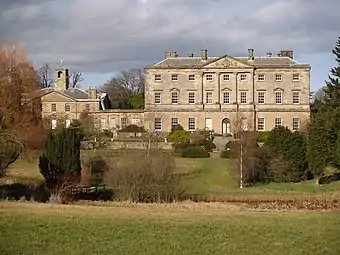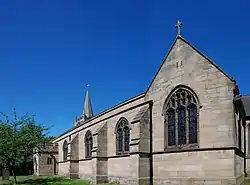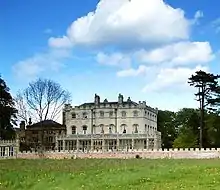


William Newton (1730–1798) was an English architect who worked mainly in Newcastle upon Tyne and Northumberland. His work shows a conventional but elegant classical style, influenced by Adam and Paine, and with a strong Palladian feel typical of late 18th century architecture. Most of his buildings are stately homes in rural Northumberland, but he also created some interesting public works in Newcastle: The Assembly Rooms, St Anne's Church, the refaced Guildhall, and elegant private housing in Charlotte Square.
He was the son of Robert Newton, a builder. He married Dorothy Bell and lived for 28 years at 1, Charlotte Square, Newcastle.[1] His big break came when he was appointed architect for The Assembly Rooms in Newcastle in 1774; as a result he became favoured by the Northumbrian elite.[2] He has been described as 'the first truly Nothumbrian architect'.[3]
His work includes:-
- The Infirmary, Newcastle 1751-2 (demolished 1954)
- Capheaton Hall (North front) 1758
- St Mungo, Simonburn (rebuilding of aisles) 1763
- St Ann's Church, Newcastle 1764
- Charlotte Square, Newcastle 1770
- Kielder Castle 1772
- Assembly Rooms, Newcastle 1774-6[4]
- Killingworth House (probably added wings) 1770s (demolished 1954)
- The Castle, Castle Eden c1775
- Shawdon Hall 1779 (probable attribution)
- Backworth Hall 1780
- Acton House 1781
- Charlton Hall 1782
- Howick Hall 1782[5]
- Heaton Hall (refronting) 1783 (demolished 1933)
- The Temple, Heaton Hall (now at Blagdon Hall) 1783
- St Nicholas Cathedral, Newcastle 1783-7, (internal restoration), with David Stephenson
- Whitfield Hall 1785
- Hebburn Hall 1790
- St Bartholomew's Church, Longbenton 1790
- Dissington Hall 1794
- Guildhall, Newcastle upon Tyne 1794, (refronting), with David Stephenson
- Hesleyside Hall (East front) 1796
- Lemmington Hall (alterations)
- Fenham Hall (attribution and date uncertain)
McCombie and Grundy[6] have used stylistic evidence to suggest some additional attributions:
- The Lodge, Capheaton village
- Craster Tower (South wing) 1769
- Close House 1779
- Newton Hall
- Togston Hall
Faulkner and Lowery[7] make one additional suggestion:
- Broome Park, Edlingham (demolished 1953)
References
.jpg.webp)
- ↑ "William Newton black plaque".
- ↑ Lost Houses of Newcastle and Northumberland (1996) Faulkner, F & Lowery, P.
- ↑ Lost Houses of Newcastle and Northumberland (1996) Faulkner, F & Lowery, P.
- ↑ https://www.assemblyrooms.co.uk/room-hire-newcastle/our-history/
- ↑ "History of Howick Hall and Gardens".
- ↑ The Buildings of England: Northumberland. (1992) Grundy, J., McCombie, G., Ryder, P., Welfare, H. & Pevsner, N.
- ↑ Lost Houses of Newcastle and Northumberland (1996) Faulkner, F & Lowery, P.
- Oxford Dictionary of National Biography. Article by Margaret Willis 2004
- The Buildings of England: Northumberland. (1992) Grundy, J., McCombie, G., Ryder, P., Welfare, H. & Pevsner, N.
- Patronage and Palladianism: the career of William Newton (1730-98), architect. Thesis by Richard Pears, Newcastle University